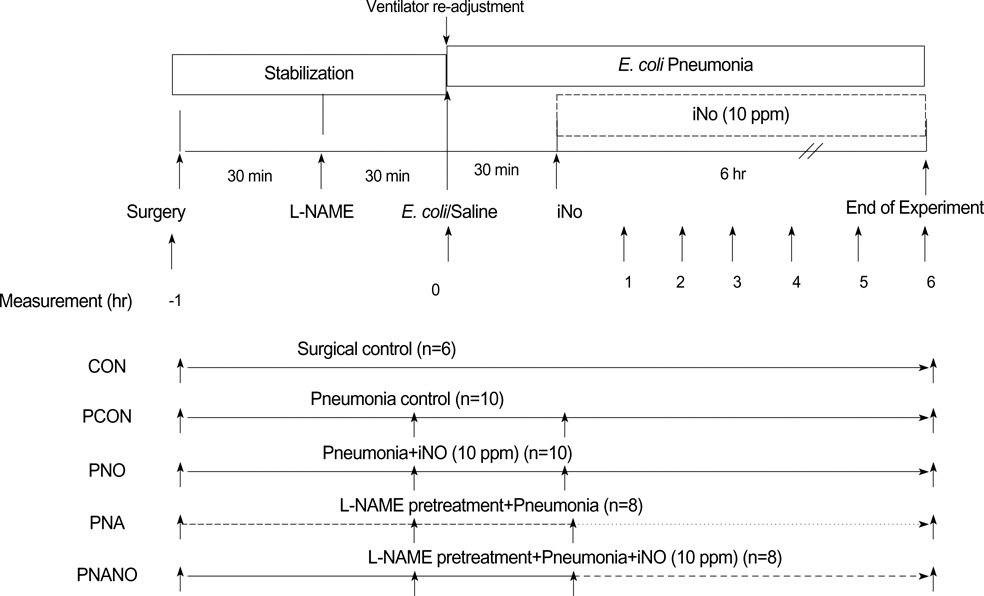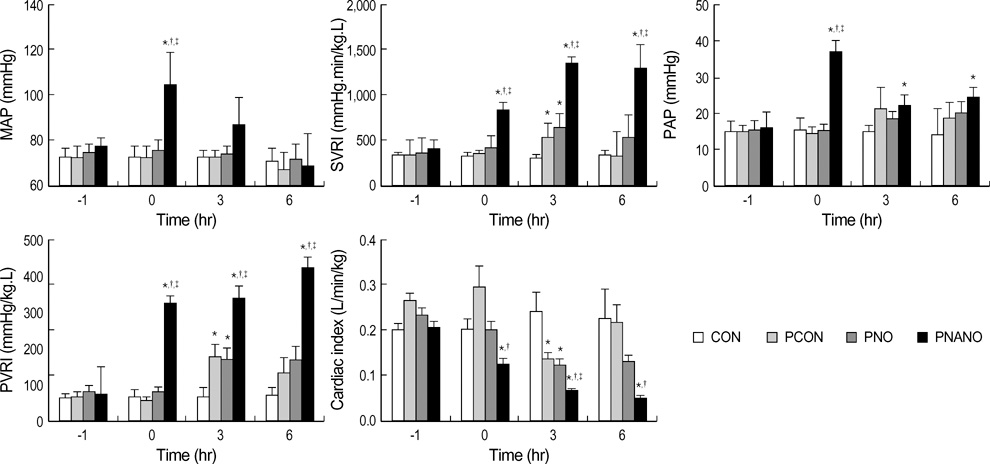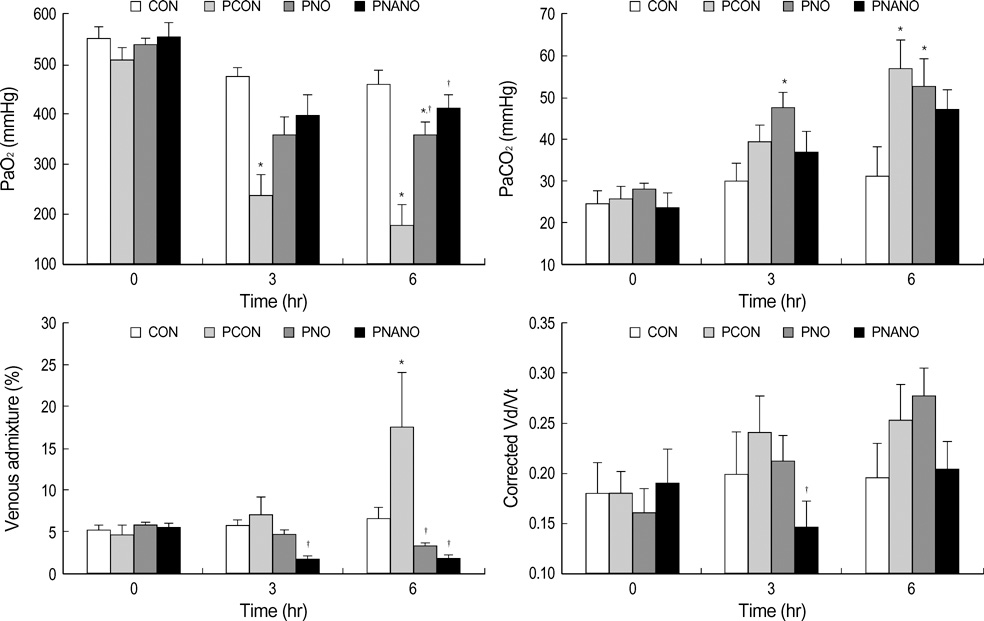J Korean Med Sci.
2006 Dec;21(6):965-972. 10.3346/jkms.2006.21.6.965.
Pretreatment with N-nitro-L-arginine Methyl Ester Improved Oxygenation After Inhalation of Nitric Oxide in Newborn Piglets with Escherichia coli Pneumonia and Sepsis
- Affiliations
-
- 1Department of Pediatrics, Samsung Medical Center, 50 Ilwon-dong, Gangnam-gu, Seoul, Korea. wspark@smc.samsung.co.kr
- 2Department of Pediatrics, Jeil Hospital, Sungkyunkwan University School of Medicine, Korea.
- 3Samsung Biomedical Research Institute, Seoul, Korea.
- KMID: 1713102
- DOI: http://doi.org/10.3346/jkms.2006.21.6.965
Abstract
- We evaluated the effects of a combined therapy of pre-blockade endogenous nitric oxide synthase (NOS) with N-nitro-L-arginine methyl ester (L-NAME) and continuous inhaled NO (iNO) on the gas exchange and hemodynamics of Escherichia coli pneumonia and sepsis in newborn piglets. Seven to ten day old ventilated newborn piglets were randomized into 5 groups: control, E. coli pneumonia control, pneumonia with iNO 10 ppm, pneumonia pre-treated with L-NAME 10 mg/kg, and pneumonia with the combined therapy of L-NAME pretreatment and iNO. E. coli pneumonia was induced via intratracheal instillation of Escherichia coli, which resulted in progressively decreased cardiac index and oxygen tension; increased pulmonary vascular resistance index (PVRI), intrapulmonary shunting, and developed septicemia at the end of 6 hr experiment. iNO ameliorated the progressive hypoxemia and intrapulmonary shunting without affecting the PVRI. Only two of 8 animals with L-NAMEpretreated pneumonia survived. Whereas when iNO was added to infected animals with L-NAME pretreatment, the progressive hypoxemia was abolished as a result of a decrease in intrapulmonary shunting without reverse of the high PVRI and systemic vascular resistance index induced by the L-NAME injection. This result suggests that a NOS blockade may be a possible supportive option for oxygenation by iNO treatment in neonatal Gram-negative bacterial pneumonia and sepsis.
Keyword
MeSH Terms
-
Treatment Outcome
Swine
Survival Rate
Sepsis/diagnosis/drug therapy/physiopathology
Pulmonary Gas Exchange/*drug effects
Premedication/*methods
Pneumonia, Bacterial/diagnosis/*drug therapy/physiopathology
Oxygen Consumption/*drug effects
Nitric Oxide Synthase/antagonists & inhibitors
Nitric Oxide/*administration & dosage
NG-Nitroarginine Methyl Ester/*administration & dosage
Injections, Intravenous
Escherichia coli Infections/diagnosis/*drug therapy/physiopathology
Drug Therapy, Combination
Animals, Newborn
Animals
Administration, Inhalation
Figure
Reference
-
1. Roberts JD Jr, Fineman JR, Morin FC 3rd, Shaul PW, Rimar S, Schreiber MD, Polin RA, Zwass MS, Zayek MM, Gross I, Heymann MA, Zapol WM. The Inhaled Nitric Oxide Study Group. Inhaled nitric oxide and persistent pulmonary hypertension of the newborn. N Engl J Med. 1997. 336:605–610.
Article2. Skimming JW, DeMarco VG, Cassin S. The effects of nitric oxide inhalation on the pulmonary circulation of preterm lambs. Pediatr Res. 1995. 37:35–40.
Article3. Rossaint R, Falke KJ, Lopez F, Slama K, Pison U, Zapol WM. Inhaled nitric oxide for the adult respiratory distress syndrome. N Engl J Med. 1993. 328:399–405.
Article4. Krafft P, Fridrich P, Fitzgerald RD, Koc D, Steltzer H. Effectiveness of nitric oxide inhalation in septic ARDS. Chest. 1996. 109:486–493.
Article5. Holzmann A, Manktelow C, Taut FJ, Bloch KD, Zapol WM. Inhibition of nitric oxide synthase prevents hyporesponsiveness to inhaled nitric oxide in lungs from endotoxin-challenged rats. Anesthesiology. 1999. 91:215–221.
Article6. Maurenbrecher H, Lamy M, Deby-Dupont G, Frascarolo P, Hedenstierna G. An animal model of response and nonresponse to inhaled nitric oxide in endotoxin-induced lung injury. Chest. 2001. 120:573–581.
Article7. Weissmann N, Voswinckel R, Tadic A, Hardebusch T, Ghofrani HA, Schermuly RT, Seeger W, Grimminger F. Nitric oxide (NO)-dependent but not NO-independent guanylate cyclase activation attenuates hypoxic vasoconstriction in rabbit lungs. Am J Respir Cell Mol Biol. 2000. 23:222–227.
Article8. Fischer SR, Deyo DJ, Bone HG, McGuire R, Traber LD, Traber DL. Nitric oxide synthase inhibition restores hypoxic pulmonary vasoconstriction in sepsis. Am J Respir Crit Care Med. 1997. 156:833–839.
Article9. Quezado ZM, Natanson C, Karzai W, Danner RL, Koev CA, Fitz Y, Dolan DP, Richmond S, Banks SM, Wilson L, Eichacker PQ. Cardiopulmonary effects of inhaled nitric oxide in normal dogs and during E. coli pneumonia and sepsis. J Appl Physiol. 1998. 84:107–115.
Article10. Barrington KJ, Etches PC, Schulz R, Talbot JA, Graham AJ, Pearson RJ, Cheung PY. The hemodynamic effects of inhaled nitric oxide and endogenous nitric oxide synthesis blockade in newborn piglets during infusion of heat-killed group B streptococci. Crit Care Med. 2000. 28:800–808.
Article11. Pedoto A, Tassiopoulos AK, Oler A, McGraw DJ, Hoffmann SP, Camporesi EM, Hakim TS. Treatment of septic shock in rats with nitric oxide synthase inhibitors and inhaled nitric oxide. Crit Care Med. 1998. 26:2021–2028.
Article12. Suzuki S, Togari H, Yamaguchi N, Haas KM. Nitric oxide inhalation and nitric oxide synthase inhibitor supplement for endotoxin-induced hypotension. Pediatr Int. 2001. 43:343–349.
Article13. Chang YS, Ko SY, Park WS. Effect of inhaled nitric oxide on hemodynamics, gas exchange, and pulmonary inflammation in newborn piglets with Escherichia coli induced septic lungs. Korean J Pediatr Soc. 2003. 46:777–783.14. Cordero L, Rau R, Taylor D, Ayers LW. Enteric gram-negative bacilli bloodstream infections: 17 years' experience in a neonatal intensive care unit. Am J Infect Control. 2004. 32:189–195.
Article15. Cordero L, Sananes M, Coley B, Hogan M, Gelman M, Ayers LW. Ventilator-associated pneumonia in very low-birth-weight infants at the time of nosocomial bloodstream infection and during airway colonization with Pseudomonas aeruginosa. Am J Infect Control. 2000. 28:333–339.
Article16. Park WS, Chang YS, Ko SY, Kang MJ, Han JM, Lee M. Efficacy of anti-tumor necrosis factor-alpha antibody as an adjunctive therapy in experimental Escherichia coli meningitis in the newborn piglet. Biol Neonate. 1999. 75:377–387.17. Duke T. Neonatal pneumonia in developing countries. Arch Dis Child Fetal Neonatal Ed. 2005. 90:211–219.
Article18. Arnold JH, Thompson JE, Benjamin PK. Respiratory deadspace measurements in neonates during extracorporeal membrane oxygenation. Crit Care Med. 1993. 21:1895–1900.
Article19. Gerlach H, Rossaint R, Pappert D, Falke KJ. Time-course and dose-response of nitric oxide inhalation for systemic oxygenation and pulmonary hypertension in patients with adult respiratory distress syndrome. Eur J Clin Invest. 1993. 23:499–502.
Article20. Kim SS, Hwang JH, Choi CW, Shim JW, Chang YS, Park WS, Oh CK. Detrimental effects of N(omega) nitro-L-arginine methyl ester (L-NAME) in experimental Escherichia coli sepsis in the newborn piglet. J Korean Med Sci. 2003. 18:637–640.21. Light RB, Mink SN, Wood LD. Pathophysiology of gas exchange and pulmonary perfusion in pneumococcal lobar pneumonia in dogs. J Appl Physiol. 1981. 50:524–530.
Article22. Marshall BE, Hanson CW, Frasch F, Marshall C. Role of hypoxic pulmonary vasoconstriction in pulmonary gas exchange and blood flow distribution. 2. Pathophysiology. Intensive Care Med. 1994. 20:379–389.23. Ogasawara H, Koizumi T, Yamamoto H, Kubo K. Effects of a selective nitric oxide synthase inhibitor on endotoxin-induced alteration in hypoxic pulmonary vasoconstriction in sheep. J Cardiovasc Pharmacol. 2003. 42:521–526.
Article24. Barnes PJ, Liu SF. Regulation of pulmonary vascular tone. Pharmacol Rev. 1995. 47:87–131.25. Moncada S, Palmer RM, Higgs EA. Nitric oxide: physiology, pathophysiology, and pharmacology. Pharmacol Rev. 1991. 43:109–142.26. Ullrich R, Bloch KD, Ichinose F, Steudel W, Zapol WM. Hypoxic pulmonary blood flow redistribution and arterial oxygenation in endotoxin-challenged NOS2-deficient mice. J Clin Invest. 1999. 104(10):1421–1429.
Article27. Sprague RS, Thiemermann C, Vane JR. Endogenous endothelium-derived relaxing factor opposes hypoxic pulmonary vasoconstriction and supports blood flow to hypoxic alveoli in anesthetized rabbits. Proc Natl Acad Sci USA. 1992. 89:8711–8715.
Article28. Spohr F, Cornelissen AJ, Busch C, Gebhard MM, Motsch J, Martin EO, Weimann J. Role of endogenous nitric oxide (NO) in endotoxin-induced alteration of hypoxic pulmonary vasoconstriction in mice. Am J Physiol Heart Circ Physiol. 2005. 289:H823–H831.29. Putensen C, Rasanen J, Downs JB. Effect of endogenous and inhaled nitric oxide on the ventilation-perfusion relationships in oleic-acid lung injury. Am J Respir Crit Care Med. 1994. 150:330–336.
Article30. Broccard AF, Feihl F, Vannay C, Markert M, Hotchkiss J, Schaller MD. Effects of L-NAME and inhaled nitric oxide on ventilator-induced lung injury in isolated, perfused rabbit lungs. Crit Care Med. 2004. 32:1872–1878.
Article31. Avontuur JA, Buijk SL, Bruining HA. Distribution and metabolism of N-nitro-L-arginine methyl ester in patients with septic shock. Eur J Clin Pharmacol. 1998. 54:627–631.
- Full Text Links
- Actions
-
Cited
- CITED
-
- Close
- Share
- Similar articles
-
- Detrimental Effects of N(w)-nitro-L-arginine Methyl Ester (L-NAME) in Experimental Escherichia coli Sepsis in the Newborn Piglet
- Effect of Inhaled Nitric Oxide on Hemodynamics, Gas Exchange and Pulmonary Inflammation in Newborn Piglets with Escherichia coli Induced Septic Lungs
- Endogenous Nitric Oxide Inhibits Na,K-ATPase Activity in the Kidney
- The Antinociceptive Effect of Intraperitoneally Administered Nonselective Nitric Oxide Synthase Inhibitor on the Rat Formalin Test
- Protective mechanism of nitric oxide and mucus against ischemia/reperfusion-induced gastric mucosal injury




